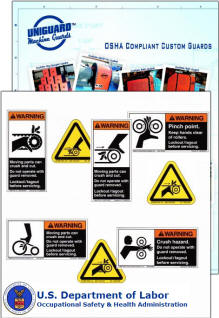Safety Compliance
Machine Guarding Requirements for Uniguard Machine Guards
Compliance with OSHA 1910.219, ANSI B11.19-2010 ,ANSI Z535, and MSHA.
-
 Required to prevent entry of hands, fingers, or other parts of the body into a point of hazard by reaching through, over, under, or around the guard.
Required to prevent entry of hands, fingers, or other parts of the body into a point of hazard by reaching through, over, under, or around the guard. -
Required to withstand a (250 lb. load or 113 Kilograms).
-
Required to prevent entry. Openings shall be no greater than 6mm (.250″).
-
Required to utilize fasteners requiring hand tools for removal.
-
Required to be constructed of a substantial material.
-
Required to have a readily visible safety label (ANSI Z535).
-
Required to be safety orange in color, when a safety color is used.
-
Required to prevent injury from component breakage. (Non-catastrophic).
-
Required to provide hinged or sliding covers when lubrication is required.
Disclaimer
Uniguards are not a Ballistic Shield The UniGuard Coupling or V-Belt guard is designed as a safety device, when used during normal operation and when properly installed and positioned, to prevent fingers, hands, arms, and clothing from contacting the rotating coupling or V-Belt Drive. The guard is not intended to be a containment shell in the event of catastrophic failure of the coupling inside the guard. The guard is not designed as a ballistic shield. Although the guards are very robust, its sole purpose is to prevent human contact in areas with potential hazard from rotating couplings or V-Belts drives.
Static Discharge
The UniGuard Coupling or V-Belt guard is designed as a safety device, when used during normal operation and when properly installed and positioned; to prevent fingers, hands, arms, and clothing from contacting the rotating/moving components. These Guards are made of a corrosion resistant engineered plastic material which is non-conductive. The materials which make up the guards do not create sparks when impacted by a striking object. They do not readily conduct electricity, so a static build up is conceivable. Thousands of these guards have been sold into various applications and to date we have never received any indication of a static discharge issue. There is no possible way to test every possible coupling/V-belt drive combination or other conditions which could lead to a static discharge. We do not recommend the use of the UniGuard machine guard in Explosion Proof areas simply as an untested precaution, not due to any known concerns.
